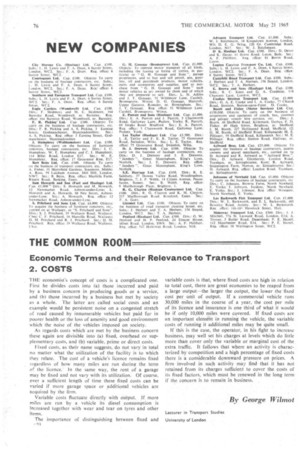THE COMMON ROOM
Page 78

If you've noticed an error in this article please click here to report it so we can fix it.
Economic Terms and their Relevance to Transport 2. COSTS
THE economist's concept of costs is a complicated one. First he -divides costs into (a) those incurred and paid by a business concern in producing goods or a service, and (b) those incurred by a business but met by society as a whole. The latter are called social costs and an example would be persistent noise on a congested stretch of road caused by innumerable vehicles but paid for in poorer health or the toss of amenity and good environment which the noise of the vehicles imposed on society.
As regards costs which are met by the business concern these again are divisible into (a) fixed, overhead or .supplementary costs, and (b) variable, prime or direct costs.
Fixed costs, as their name suggests, do riot vary in total no matter what the utilization of the facility is to which they relate. The cost of a vehicle's licence remains fixed regardless of how many miles are run during the term or the licence.In the same way, the rent of a garage may be fixed and not vary with its utilization. Of course, over a sufficient length of time these fixed costs can be varied if more garage space or additional vehicles are acquired by the firm.
Variable costs fluctuate directly with output. If more miles are run by a vehicle its diesel consumption is increased together with wear and tear on tyres and other items.
The importance of distinguishing between fixed and variable costs is that, where fixed costs are high in relation to total cost, there are great economies to be reaped from a large output-the larger the output, the lower the fixed cost per unit of output. If a commercial vehicle runs 30,000 miles in the course of a year, the cost per mile of its licence and insurance is one third of what it would be if only 10,000 miles were covered. If fixed costs are an important element in running the vehicle, the variable costs of running it additional miles may be quite small.
If this is the case,, the operator, in his fight to increase business, may well set his charges at levels which do little more than cover only the variable or marginal cost of the extra traffic. It follows that where an activity is characterized by competition and a high percentage of fixed costs there is a considerable downward pressure on prices. A firm involved in such activity may find that it has not retained from its charges sufficient to cover the costs of its fixed factors, which must be renewed in the long term if the concern is to remain in business.
By George Wilmot
Lecturer in Transport Studies University of London
























































































































